Summer Fellowship Online Exhibits
As part of our mission to provide research opportunities to students and to promote the study of post-Holocaust American Jewish history, the Program in Jewish Studies, in conjunction with the Department of History, the Center for Humanities and the Arts and the University Libraries, provides fellowship opportunities in the Innovations in Jewish Life Collection. Beginning in 2017, these fellowships required a digital component to be created in addition to conducting original research and working with archival collections.
Learn more about the PHAJ fellowship opportunities
This section contains the resulting digital exhibits created by our student fellows. Please select which exhibit you would like to view and you will be taken to the digital resource.
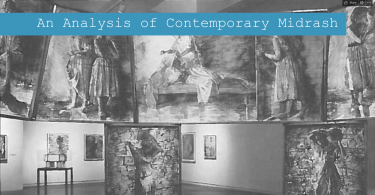
Intersectionality: What Contemporary Midrash Taught Me about Collaborative Art Making and My Appalachian Identity by Kelley Walsh
Kelley's summer research explores materials in the Institute for Contemporary Midrash Records, focusing primarily on the concept of midrash as represented in the Institute's eight volumes of In Living Text. In her presentation, Kelley will discuss how midrash has informed her work both as a dance artist-scholar and on a personal level unpacking her own identity as an Appalachian currently living outside of Appalachia. She will also discuss how her research in the PHAJ Collections has impacted her joint collaborations with Affrilachian artist-scholar Yunina Barbour Payne creating a dance theater work that explores Appalachian and Affrilachian identity.
Digital exhibit created using Microsoft Sway.
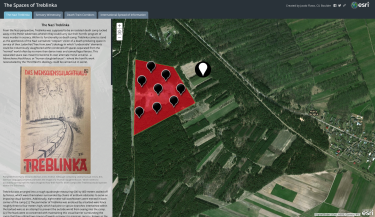
Witnessing Treblinka: Mapping Death Camp Spaces by Jacob Flaws
Using materials in the Harry W. Mazal Collection, Jacob's summer research project digitally maps the different spaces of the Treblinka death camp and the surrounding area. In his presentation, he will discuss how the Nazis intended Treblinka as an expression of their horrific phantasmagoric worldview wherein Jews could conceivably be industriously slaughtered within a completely isolated and concealed space. Yet, because of the sheer magnitude of mass murder carried out at the death camp the sights, sounds, and smells of Treblinka were ejected across the local landscape. Therefore, local Polish and Jewish inhabitants witnessed Treblinka, both directly and indirectly, even from outside of the camp's camouflaged fences.
Digitial exhibit created using ArcGIS.
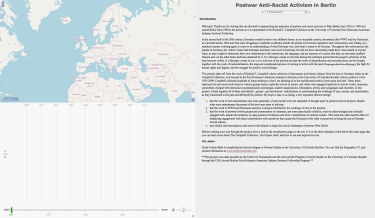
Postwar Anti-Racist Activism in Berlin by Emily Frazier-Rath
Emily's project focuses on the Richard E. Campbell Collection. From 1953-2009, Richard E. Campbell collected hundreds of items relating to what Emily refers to as the multifaceted world of anti-racist activism. In her project, Emily pieces together anti-racist work done by various groups, museums, filmmakers, artists, synagogues, and churches to understand the workings of race, racism, and racialization as they functioned in the past (especially during the Nazi era) and as they both reflect and inform Germany’s postwar present. She will present postwar anti-racist activism in (West) Berlin, Germany as it is represented in the Campbell Collection in multiple ways: temporally (on a timeline), spatially (on a map), and through narrative.
Digitial exhibit created using VisualEyes.
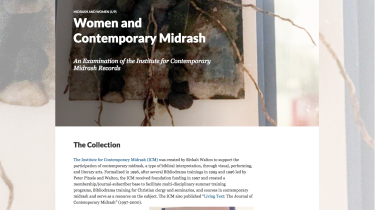
Women and Contemporary Midrash: An Examination of the Institute for Contemporary Midrash Records Collection at the University of Colorado by Amber Manning
In a letter of endorsement for the Institute for Contemporary Midrash (written after participating in a midrash training), Rosalind Glazer claims, simply, “for women—midrash matters” (Box 12, ICMR). In the Institute for Contemporary Midrash Records archive exhibit I created, I sought to examine and uncover why midrash is so important to and for women. Overall, documents from the collection indicate that contemporary midrash, as both a process and a product, creates a community for women, a community that facilitates a deeper relationship with the Torah, with Judaism, and with other women.
Digital exhibit created using Scalar.
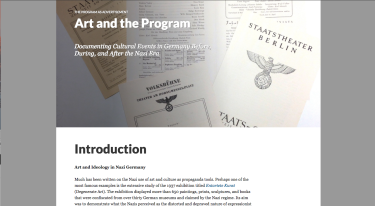
The Program as Advertisement: Art and Propaganda in Concert and Theater Programs, Exhibition Catalogues, and Brochures in Germany 1913-1961 by Adi Nester
The majority of the documents from the Richard Campbell Collection are from cultural events that took place between 1933 and 1945 in Germany. Adi Nester's project offers a curated collection of these programs, brochures, and catalogues from before, during, and shortly after the period of Nazi regime in Germany. It presents these items in an interactive online exhibit that progresses chronologically from 1913 to 1961. The aim of the project is to explore the medium of the program, brochure, or catalogue as an instrument that reflects the social and ideological tendencies of its time.
Digital exhibit created using Scalar.
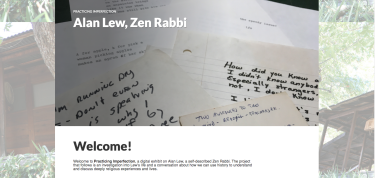
Practicing Imperfection: A Zen Rabbi and the Limits of Historical Inquiry by Jason Hogstad
Alan Lew had always felt little connection to his Jewish faith. He began practicing Zen Buddhism before reconnecting with his roots and studying as a rabbi to incorporate meditation into Jewish spiritual practice. His life was characterized by his desire to embrace what he described as a "realm beyond language." Jason Hogstad's online exhibit, "Practicing Imperfection" asks audiences to think about how we can make sense of the life of Alan Lew, and in doing so, to wrestle with the limits of historical inquiry he identified.
Digital exhibit created using Scalar.


